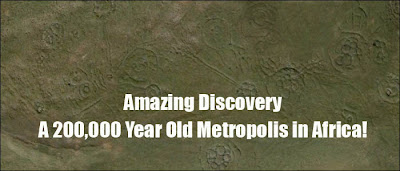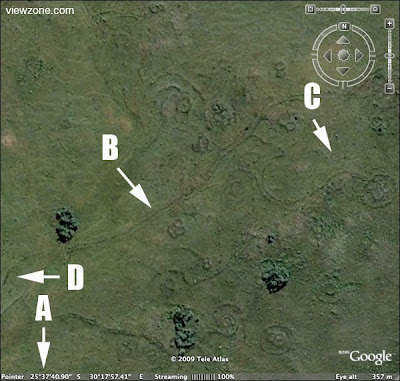
古代人類都會發現在非洲
Ancient Human Metropolis Found in Africa
By Dan Eden for viewzone.
They have always been there. People noticed them before. But no one could remember who made them -- or why? Until just recently, no one even knew how many there were. Now they are everywhere -- thousands -- no, hundreds of thousands of them! And the story they tell is the most important story of humanity. But it's one we might not be prepared to hear.
Something amazing has been discovered in an area of South Africa, about 150 miles inland, west of the port of Maputo. It is the remains of a huge metropolis that measures, in conservative estimates, about 1500 square miles. It's part of an even larger community that is about 10,000 square miles and appears to have been constructed -- are you ready -- from 160,000 to 200,000 BCE!
The image [top of page] is a close-up view of just a few hundred meters of the landscape taken from google-earth. The region is somewhat remote and the "circles" have often been encountered by local farmers who assumed they were made by some indigenous people in the past. But, oddly, no one ever bothered to inquire about who could have made them or how old they were.
This changed when researcher and author, Michael Tellinger, teamed up with Johan Heine, a local fireman and pilot who had been looking at these ruins from his years flying over the region. Heine had the unique advantage to see the number and extent of these strange stone foundations and knew that their significance was not being appreciated.
"When Johan first introduced me to the ancient stone ruins of southern Africa, I had no idea of the incredible discoveries we would make in the year or two that followed. The photographs, artifacts and evidence we have accumulated points unquestionably to a lost and never-before-seen civilization that predates all others -- not by just a few hundred years, or a few thousand years... but many thousands of years. These discoveries are so staggering that they will not be easily digested by the mainstream historical and archaeological fraternity, as we have already experienced. It will require a complete paradigm shift in how we view our human history. " -- Tellinger
它在那裡被發現
Where it was found
 The area is significant for one striking thing -- gold. "The thousands of ancient gold mines discovered over the past 500 years, points to a vanished civilization that lived and dug for gold in this part of the world for thousands of years," says Tellinger. "And if this is in fact the cradle of humankind, we may be looking at the activities of the oldest civilization on Earth."
The area is significant for one striking thing -- gold. "The thousands of ancient gold mines discovered over the past 500 years, points to a vanished civilization that lived and dug for gold in this part of the world for thousands of years," says Tellinger. "And if this is in fact the cradle of humankind, we may be looking at the activities of the oldest civilization on Earth."To see the number and scope of these ruins, I suggest that you use google-earth and start with the following coordinates:
Carolina -- 25 55' 53.28" S / 30 16' 13.13" E
Badplaas -- 25 47' 33.45" S / 30 40' 38.76" E
Waterval -- 25 38' 07.82" S / 30 21' 18.79" E
Machadodorp -- 25 39' 22.42" S / 30 17' 03.25" E
Then perform a low flying search inside the area formed by this rectangle. Simply Amazing!
Did gold play some role in the dense population that once lived here? The site is just about 150 miles from an excellent port where maritime trade could have helped to support such a large population. But remember -- we're talking almost 200,000 years ago!
The individual ruins [see below] mostly consist of stone circles. Most have been buried in the sand and are only observable by satellite or aircraft. Some have been exposed when the changing climate has blown the sand away, revealing the walls and foundations.
 "I see myself as a fairly open-minded chap but I will admit that it took me well over a year for the penny to drop, and for me to realise that we are actually dealing with the oldest structures ever built by humans on Earth.
"I see myself as a fairly open-minded chap but I will admit that it took me well over a year for the penny to drop, and for me to realise that we are actually dealing with the oldest structures ever built by humans on Earth.The main reason for this is that we have been taught that nothing of significance has ever come from southern Africa. That the powerful civilizations all emerged in Sumeria and Egypt and other places. We are told that until the settlement of the BANTU people from the north, which was supposed to have started sometime in the 12th century AD, this part of the world was filled by hunter gatherers and so-called Bushmen, who did not make any major contributions in technology or civilization." -- Tellinger
一豐富及多元的歷史
A Rich and Diverse History
 When explorers first encountered these ruins, they assumed that they were cattle corals made by nomadic tribes, like the Bantu people, as they moved south and settled the land from around the 13th century. There was no previous historical record of any older civilization capable of building such a densly populated community. Little effort was made to investigate the site because the scope of the ruins was not fully known.
When explorers first encountered these ruins, they assumed that they were cattle corals made by nomadic tribes, like the Bantu people, as they moved south and settled the land from around the 13th century. There was no previous historical record of any older civilization capable of building such a densly populated community. Little effort was made to investigate the site because the scope of the ruins was not fully known.Over the past 20 years, people like Cyril Hromnik, Richard Wade, Johan Heine and a handful of others have discovered that these stone structures are not what the seem to be. In fact these are now believed to be the remains of ancient temples and astronomical observatories of lost ancient civilizations that stretch back for many thousands of years.
 These circular ruins are spread over a huge area. They can only truly be appreciated from the air or through modern sattelite images. Many of them have almost completely eroded or have been covered by the movement of soil from farming and the weather. Some have survived well enough to reveal their great size [see above] with some original walls standing almost 5 feet high and over a meter wide in places.
These circular ruins are spread over a huge area. They can only truly be appreciated from the air or through modern sattelite images. Many of them have almost completely eroded or have been covered by the movement of soil from farming and the weather. Some have survived well enough to reveal their great size [see above] with some original walls standing almost 5 feet high and over a meter wide in places.Looking at the entire metropolis, it becomes obvious that this was a well planned community, developed by a highly evolved civilization. The number of ancient gold mines suggests the reason for the community being in this location. We find roads -- some extending a hundred miles -- that connected the community and terraced agriculture, closely resembling those found in the Inca settlements in Peru.
But one question begs for an answer -- how could this be achieved by humans 200,000 years ago?
 一個例子 您將從谷歌地球看到的東西
一個例子 您將從谷歌地球看到的東西An example of what you will see on google-earth.This is what you will see on google-earth at 25 37'40.90"S / 30 17'57.41E [A]. We are viewing the scene from an altitude of 357 meters.
This is not a "special" location -- just one we picked at random, within the previously described area. It shows artifacts that are everywhere and we encourage you to search the area with this great internet technology.
The circular stone structures are obvious from this view, even though they may not be visible from ground level. Notice that there are many very long roads [B] that connect groups of the circular structures. If you zoom out and follow these "roads" they travel for many miles.
The fact that we can see these structures is mainly because natural erosion has blown away the dirt and debris that has covered them for thousands of years. Once exposed to the wind, the rocks are scoured clean and may appear deceptively new.
If you look closely at what first appears to be empty land [C], you will notice many faint circles, indicating that even more dwellings lurk below the surface. In reality, the entire area is packed full of these structures and connecting roads.
Why has no one notices these before?
為什麼之前沒有人注意這些?
地點如何定日期
How the Site was dated
Once the ruins were examined, the researchers were anxious to place the lost civilization in a historical perspective. The rocks were covered with a patina that looked very old but there were no items sufficient for carbon-14 dating. It was then that a chance discovery revealed the age of the site, and sent a chill down the spine of archaeologists and historians!
http://viewzone2.com/adamscalendarx.html?54a4b008
非洲發現人類發源地!
(商台)2010年7月28日 星期三 15:49
【商台 互動國際組】上帝創造人類時將亞當和夏娃安置在伊甸園,近日美國 科學家在非洲 南岸地區發現遠古人類的「伊甸園」。
遠古人類「伊甸園」
美國亞利桑那州立大學(Arizona State University)人類起源研究所的科學家對南非開普敦東部尖峰地區進行考察,科學家在岩洞裏發現可追溯至164000年前的遠古人類遺跡,經研究證實該區域在195000年前冰河時期是遠古人類的棲息地。
人類曾面臨絕種危機
由於當時惡劣氣候變化令大部分地球人種滅絕,最終地球僅剩數百遠古智人倖存下來,隨後他們居住非洲南岸尖峰地區,現今人類就是這數百名遠古智人的後代,現時該區域被譽為遠古人類的「伊甸園」。
http://hk.news.yahoo.com/article/100728/18/je7q.html
南非岩洞是人類伊甸園
2010年07月28日(三)
【本報訊】美國有研究指出,在冰河時期,人類的祖先在南非沿海的岩洞熬過嚴寒天氣存活下來,再繁衍成今天的人類,當時人口僅剩數百人。
發現16萬年前工具
科學家在南非開普敦以東約四百公里的平納克爾角(Pinnacle Point)沿海岩洞,發現古人類的工具,可追溯至十六萬四千年以前,當時正值冰河時期,推算人類祖先就在該處熬過嚴寒天氣,再繁衍成今天的人類。科學家稱該處為人類的伊甸園。
負責研究的亞利桑那州州立大學教授馬雷(Curtis Marean)表示,在冰河時期,該區域仍有豐饒的植物,而且一些營養物隨水流沖到近岸吸引魚群,為當時的古人類提供足夠糧食。
不過,倫敦自然歷史博物館的斯特林格教授稱,不相信人類祖先來自單一的源頭,考古學家曾在埃塞俄比亞掘出十六萬年前的人類遺骸化石,摩洛哥也有類似發現。
http://the-sun.on.cc/cnt/china_world/20100728/00423_032.html?pubdate=20100728
谷歌地球上的亞特蘭蒂斯
隱藏的人類歷史
較古老的類人在矮人島發現
400萬年之謎:似樹巨物在樹存在前的時代
考古學家揭示巨人歌利亞的故鄉
世紀性發現 - 古代電力裝置被發現在大金字塔的證據?
南非現10萬年前顏料作坊 証實人類思維能力
沒有留言:
發佈留言